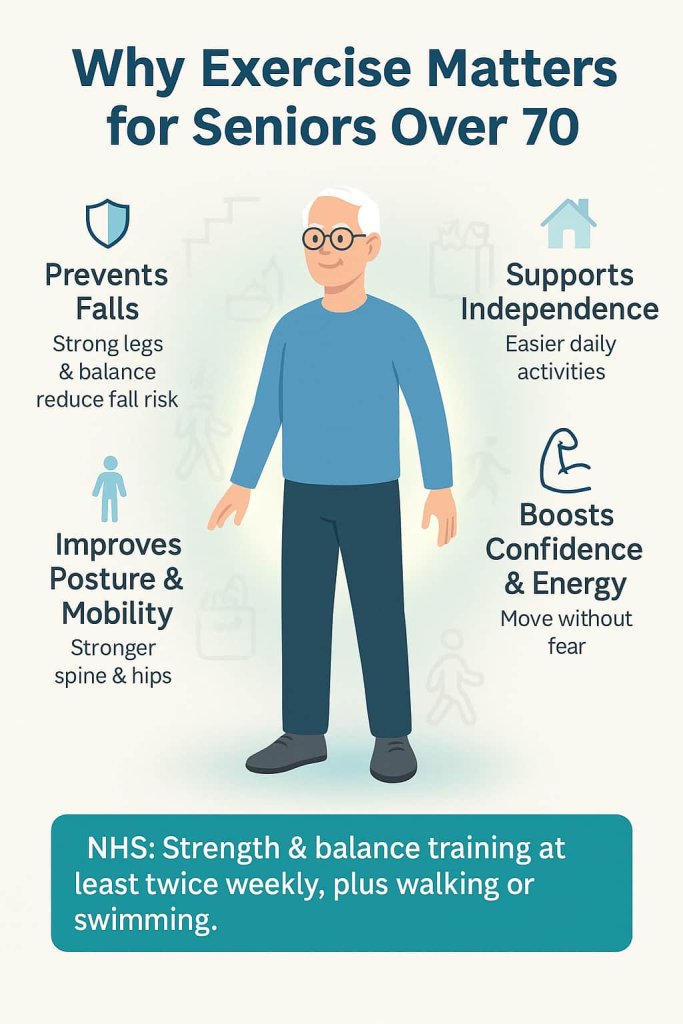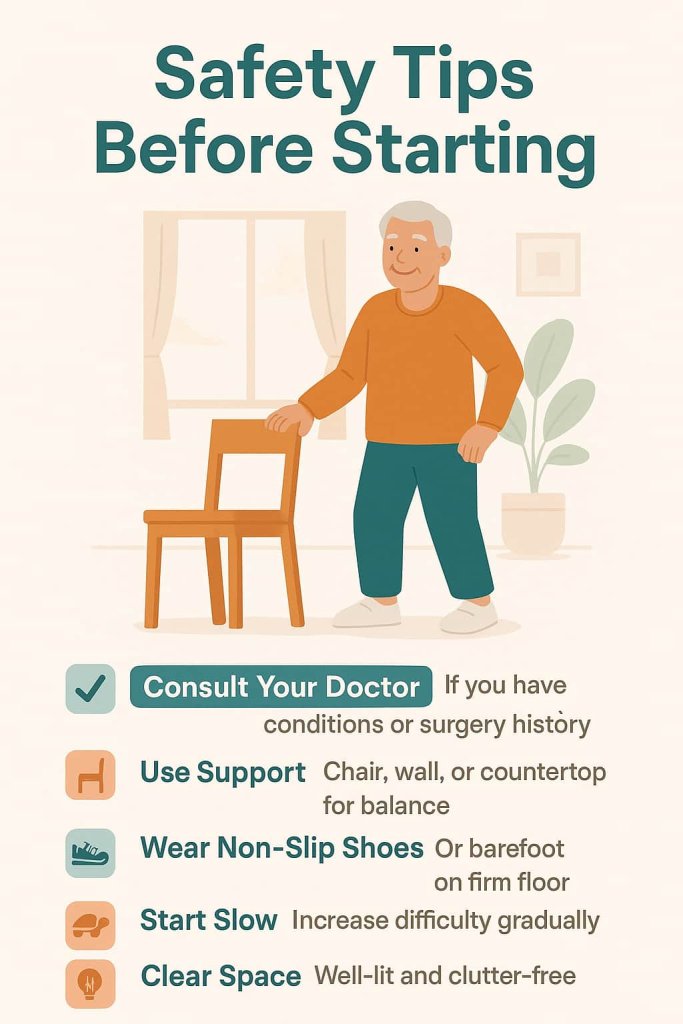Yes, seniors over 70 can safely exercise to boost strength and balance. In fact, research shows that regular strength and balance training helps reduce falls, improve independence, and keep muscles strong even in later years. According to the CDC, 1 in 4 adults aged 65+ experiences a fall every year in the U.S., making balance and strength workouts essential for safety and quality of life.

The good news is, you don’t need heavy gym equipment or intense workouts. With simple, low-impact exercises, you can build confidence, move better, and stay active. Below are 12 safe and effective exercises for seniors over 70 — each designed to improve strength, mobility, and stability.
Why Exercise Matters for Seniors Over 70

- Prevents Falls: Stronger legs, core, and balance reduce fall risk.
- Supports Independence: Makes daily tasks like standing, climbing stairs, and carrying groceries easier.
- Improves Posture & Mobility: Strengthens muscles that support your spine and hips.
- Boosts Confidence & Energy: Regular activity helps you feel steady and move without fear.
- Protects Long-Term Health: Reduces risk of chronic diseases and supports bone density.
👉 The NHS recommends older adults do strength and balance training at least twice a week, alongside aerobic activity such as walking or swimming (NHS Physical Activity Guidelines).
Safety Tips Before Starting

- Always consult your doctor if you have chronic conditions, surgery history, or balance issues.
- Use a sturdy chair, wall, or countertop for support.
- Wear non-slip shoes or go barefoot on a firm surface.
- Start slow and increase difficulty gradually.
- Exercise in a clutter-free, well-lit space.
12 Best Exercises for Seniors Over 70
Staying active after 70 is one of the best ways to maintain independence, prevent falls, and keep your body strong. These 12 safe and effective exercises target strength, mobility, balance, and joint health — all crucial for seniors. Each move can be done at home with little or no equipment.
1. Sit-to-Stand (Chair Squat)
How to:
- Sit on a sturdy chair with feet flat on the floor, hip-width apart.
- Lean forward slightly, keeping your back straight.
- Push through your heels and stand tall.
- Slowly lower back down under control.
Benefits:
- Builds leg and hip strength.
- Improves independence for daily tasks like standing from a chair or toilet.
- Enhances balance and coordination.
Tip: Start with 5–10 reps. Use armrests for support if needed. As you get stronger, try crossing your arms over your chest.
2. Wall Push-Ups
How to:
- Stand facing a wall, arms extended at shoulder height.
- Place hands flat on the wall, slightly wider than shoulders.
- Bend elbows to bring chest closer to the wall.
- Push back to starting position.
Benefits:
- Strengthens chest, shoulders, and arms without heavy strain.
- Supports upper body function for lifting and reaching.
Tip: Step further back for more challenge. Beginners can stand closer to the wall.
3. Single-Leg Balance
How to:
- Stand tall near a chair or wall for support.
- Lift one foot 2–3 inches off the ground.
- Hold for 10–20 seconds, then switch sides.
Benefits:
- Improves balance and ankle stability.
- Reduces fall risk.
- Trains coordination.
Tip: Hold the chair lightly at first. Over time, try extending your arms out for more challenge.
4. Heel Raises (Calf Raises)
How to:
- Stand tall, feet hip-width apart.
- Hold the back of a chair for support.
- Lift heels off the floor to stand on your toes.
- Lower back down slowly.
Benefits:
- Strengthens calves and ankles.
- Improves walking stability.
- Helps with climbing stairs.
Tip: Perform 10–15 reps. Progress to doing them without support or on a step for more intensity.
5. Marching in Place
How to:
- Stand tall with feet hip-width apart.
- Slowly march in place by lifting knees toward hips.
- Continue for 30–60 seconds.
Benefits:
- Strengthens hip flexors and legs.
- Boosts circulation.
- Improves rhythm and coordination.
Tip: Use a chair or wall for balance if needed. Vary pace to add light cardio.
6. Side-Leg Raise
How to:
- Stand behind a sturdy chair.
- Slowly lift one leg out to the side (keep toes facing forward).
- Return to starting position.
- Repeat on both sides.
Benefits:
- Strengthens hip abductors (outer thighs and hips).
- Supports balance and walking.
- Protects against falls.
Tip: Start with 8–10 reps per leg. Avoid leaning sideways.
7. Step-Ups
How to:
- Find a low step or stair (4–6 inches high).
- Step up with one foot, then bring the other foot up.
- Step back down and repeat, alternating legs.
Benefits:
- Builds leg strength.
- Improves stair-climbing ability.
- Trains coordination and endurance.
Tip: Hold a rail or wall for safety. Start with 5 reps each leg.
8. Seated or Dumbbell Row
How to:
- Sit tall in a chair with a straight back.
- Hold light dumbbells (1–3 lbs) or a resistance band.
- Pull elbows back while squeezing shoulder blades.
- Slowly return to start.
Benefits:
- Strengthens back muscles.
- Improves posture and reduces slouching.
- Supports shoulder stability.
Tip: Keep movements slow and controlled. Avoid shrugging shoulders.
9. Glute Bridge
How to:
- Lie on your back with knees bent, feet flat on the floor.
- Press heels into the floor.
- Lift hips until your body forms a straight line from shoulders to knees.
- Lower slowly.
Benefits:
- Strengthens glutes, hips, and lower back.
- Improves core stability.
- Supports walking and standing.
Tip: Place a small cushion under your head for comfort. Hold at the top for 2–3 seconds.
10. Weight Shifts (Tai Chi Style)
How to:
- Stand with feet hip-width apart.
- Slowly shift weight onto one leg, then the other.
- Focus on smooth, controlled movements.
Benefits:
- Improves balance and body awareness.
- Builds lower-body control.
- Provides a foundation for Tai Chi.
Tip: Start with simple shifts, then progress to adding arm sweeps or small Tai Chi patterns.
11. Water Walking (Aquatic Exercise)
How to:
- Walk forward and backward in waist-deep water.
- Swing arms naturally as you step.
- Try sideways walking for variety.
Benefits:
- Low-impact exercise gentle on joints.
- Water resistance strengthens muscles.
- Safe environment for seniors with arthritis or joint pain.
Tip: Hold onto the pool rail if needed. Start with 5–10 minutes.
12. Heel-to-Toe Walk (Tandem Walk)
How to:
- Stand tall near a wall for support.
- Place heel of one foot directly in front of toes of the other.
- Take 10–20 slow, careful steps forward.
Benefits:
- Improves balance and walking stability.
- Strengthens ankle and foot muscles.
- Helps prevent trips and stumbles.
Tip: Look straight ahead, not down at your feet.
How Often Should Seniors Over 70 Exercise?
- Strength training: At least 2 days per week.
- Balance training: Daily short sessions (5–10 min).
- Aerobic activity: 150 minutes per week (e.g., walking, swimming, cycling).
👉 The Journal of Strength & Conditioning Research notes that resistance training is both safe and highly effective for older adults, even into their 80s.
FAQs
1. What exercise should a 70-year-old do every day?
Gentle balance and mobility moves like heel raises, single-leg stands, or short walks are safe daily.
2. Can a 70-year-old still build muscle?
Yes. Studies confirm that resistance training builds strength and muscle mass in older adults.
3. How long should a senior work out each day?
Aim for 20–30 minutes most days, but even 10-minute sessions add up.
4. What is the safest strength exercise for seniors?
Sit-to-stand (chair squats) and wall push-ups are safe, low-impact starters.
5. Should seniors over 70 avoid certain exercises?
High-impact, heavy lifting without supervision, and twisting spine moves should be avoided unless cleared by a doctor.
6. Is walking enough exercise for seniors?
Walking is excellent for heart health, but adding strength and balance exercises provides better protection against falls.
7. Can seniors with arthritis exercise safely?
Yes — low-impact moves like water exercise, seated rows, and Tai Chi are arthritis-friendly.
Conclusion
Exercising after 70 isn’t about pushing limits — it’s about staying strong, balanced, and independent. With simple exercises like sit-to-stand, heel raises, and glute bridges, you can protect your joints, improve posture, and reduce fall risk.
👉 Start small, stay consistent, and you’ll feel the difference in daily activities.
